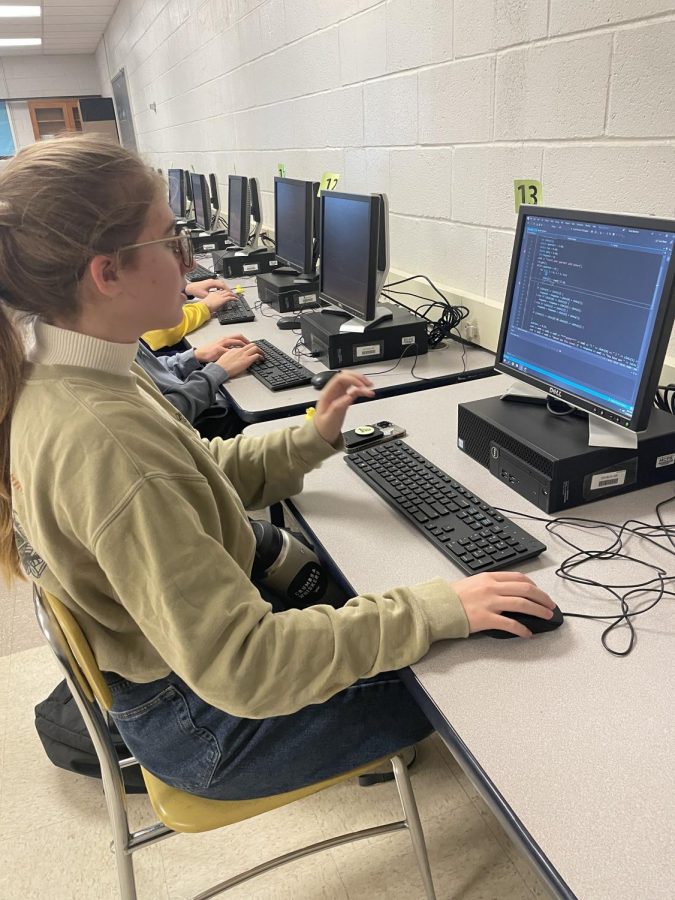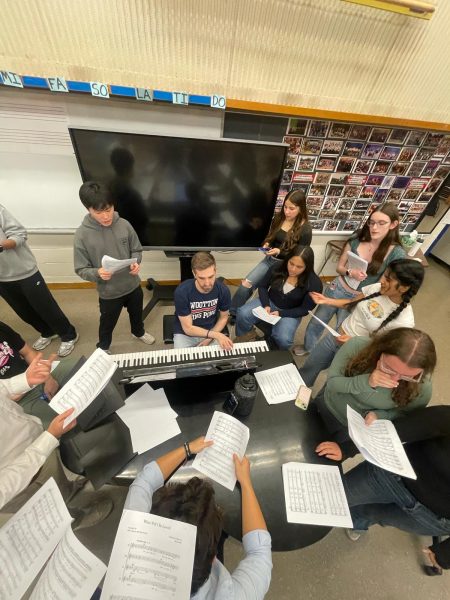Students weigh in on how to get more girls involved in AOIT, STEM
Freshman and AOIT memberJulia Kleinbussink works on code for a choice program that will create a fruit slot machine.
Women have been historically underrepresented in STEM fields, making up 28% of the workforce. In the Academy of Information Technology (AOIT), a program dedicated to introducing students to careers in technology, this gender imbalance is seen as well. Girls make up about 25% of AOIT students, and this percentage has risen over the years.
Students and teachers who believe that schools don’t have to worry about diversity or inclusivity feel that it is not in teachers’ job descriptions to get more girls involved. They should just let girls take the classes they want and not worry about the obvious gender imbalance in AOIT.
However, they fail to realize the impact of the underrepresentation of women in science, technology, engineering and math (STEM) fields. The reasons behind this gap vary from the underpayment of women, which leads to them leaving the industry, to stereotypes that lead girls to believe that they don’t belong in STEM. If these patterns continue, it could isolate girls and women wanting to pursue a career in STEM.
How can AOIT break this cycle? What can be done to get more girls involved? AOIT is already attempting to decrease the gap. James Turner, technology teacher and AOIT coordinator, said that the program has had sessions in which upperclassmen AOIT girls talk to freshmen. Technology teachers have also been speaking with girls about joining.
One thing to note about AOIT is that applications start in eighth grade. One of the requirements of the program is taking specific classes that align with one’s pathway all four years, meaning that upperclassmen would not be able to join had they not taken the required classes previously. “Because of the way the application process is set up, I think programming workshops that teach middle schoolers how to code, or hackathons that don’t require coding knowledge would help girls gain an interest,” junior Sudiksha Purohit said.
One reason why girls are less likely to pursue careers in STEM is because of the lack of exposure they have to these specific career fields at a young age. “Maybe Patriot Ambassadors could go to middle schools to talk about AOIT to increase exposure. Sending people to schools to talk about AOIT will allow for Q&A sessions and will increase interest. If we continue to reinforce the idea of technology, and the careers emerging from it, I feel like girls will be interested in joining AOIT and then going into tech in the future,” senior Anjali Gallagher said.
To decrease the gender gap further, students feel AOIT should host events directed specifically to girls. “AOIT could do a buddy program to make new AOIT girls more comfortable and excited. When freshmen join, they can have a senior meet with them to encourage them to take full advantage of the program. Joining AOIT as one of the few girls can be intimidating, so if we show girls that there are people in AOIT they can talk to, they might feel more at ease,” senior Adithi Vardhan said.
In short, increasing exposure of STEM careers to girls early on in their lives will stimulate passion and decrease the gender imbalance for the future.
Your donation will support the student journalists of Thomas S. Wootton High School. Your contribution will allow us to purchase equipment and cover our annual website hosting costs.
Naeha is a 2024 graduate.






![The 2025-2026 Editorial Board Alex Grainger, Cameron Cowen, Helen Manolis, Emory Scofield, Ahmed Ibrahim, Rebekah Buchman, Marley Hoffman, Hayley Gottesman, Pragna Pothakamuri and Natalie Pak (Chase Dolan not pictured) respond to the new MCPS grading policy. “When something that used to be easy suddenly becomes harder, it can turn [students’] mindset negative, whereas making something easier usually has a better impact. I think that’s where a lot of the pushback comes from. But if you put emotions aside, I do think this change could help build stronger work ethic,” Ibrahim said.](https://woottoncommonsense.com/wp-content/uploads/2025/09/fqr5bskTXpn0LRQMmKErLuNKdQYBlL726cFXBaWF-600x450.jpg)

Dhruv Das • Dec 16, 2022 at 12:21 PM
This is such an insightful article!